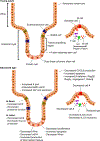Age-related changes in intestinal immunity and the microbiome
- PMID: 33020981
- PMCID: PMC8139861
- DOI: 10.1002/JLB.3RI0620-405RR
Age-related changes in intestinal immunity and the microbiome
Abstract
The gastrointestinal (GI) tract is a vitally important site for the adsorption of nutrients as well as the education of immune cells. Homeostasis of the gut is maintained by the interplay of the intestinal epithelium, immune cells, luminal Ags, and the intestinal microbiota. The well-being of the gut is intrinsically linked to the overall health of the host, and perturbations to this homeostasis can have severe impacts on local and systemic health. One factor that causes disruptions in gut homeostasis is age, and recent research has elucidated how critical systems within the gut are altered during the aging process. Intestinal stem cell proliferation, epithelial barrier function, the gut microbiota, and the composition of innate and adaptive immune responses are all altered in advanced age. The aging population continues to expand worldwide, a phenomenon referred to as the "Silver Tsunami," and every effort must be made to understand how best to prevent and treat age-related maladies. Here, recent research about changes observed in the intestinal epithelium, the intestinal immune system, the microbiota, and how the aging gut interacts with and influences other organs such as the liver, lung, and brain are reviewed. Better understanding of these age-related changes and their impact on multi-organ interactions will aid the development of therapies to increase the quality of life for all aged individuals.
Keywords: epithelium; inflammaging; inflammation; liver; lung; microbiome.
©2020 Society for Leukocyte Biology.
Conflict of interest statement
Conflict-of-Interest Disclosure
The authors declare no conflict of interest.
Figures


Similar articles
-
Intestinal barrier and gut microbiota: Shaping our immune responses throughout life.Tissue Barriers. 2017 Oct 2;5(4):e1373208. doi: 10.1080/21688370.2017.1373208. Epub 2017 Sep 28. Tissue Barriers. 2017. PMID: 28956703 Free PMC article. Review.
-
The Impact of Dietary Sphingolipids on Intestinal Microbiota and Gastrointestinal Immune Homeostasis.Front Immunol. 2021 May 14;12:635704. doi: 10.3389/fimmu.2021.635704. eCollection 2021. Front Immunol. 2021. PMID: 34054805 Free PMC article. Review.
-
The Intestinal Epithelium: Central Coordinator of Mucosal Immunity.Trends Immunol. 2018 Sep;39(9):677-696. doi: 10.1016/j.it.2018.04.002. Epub 2018 Apr 30. Trends Immunol. 2018. PMID: 29716793 Review.
-
Functions of innate immune cells and commensal bacteria in gut homeostasis.J Biochem. 2016 Feb;159(2):141-9. doi: 10.1093/jb/mvv119. Epub 2015 Nov 27. J Biochem. 2016. PMID: 26615026 Free PMC article. Review.
-
Microbes, metabolites, and the gut-lung axis.Mucosal Immunol. 2019 Jul;12(4):843-850. doi: 10.1038/s41385-019-0160-6. Epub 2019 Apr 11. Mucosal Immunol. 2019. PMID: 30976087 Review.
Cited by
-
Targeting immunosenescence for improved tumor immunotherapy.MedComm (2020). 2024 Oct 28;5(11):e777. doi: 10.1002/mco2.777. eCollection 2024 Nov. MedComm (2020). 2024. PMID: 39473905 Free PMC article. Review.
-
A Pectic Polysaccharide from Codonopsis pilosula Alleviates Inflammatory Response and Oxidative Stress of Aging Mice via Modulating Intestinal Microbiota-Related Gut-Liver Axis.Antioxidants (Basel). 2023 Sep 19;12(9):1781. doi: 10.3390/antiox12091781. Antioxidants (Basel). 2023. PMID: 37760084 Free PMC article.
-
Airborne Exposure to Pollutants and Mental Health: A Review with Implications for United States Veterans.Curr Environ Health Rep. 2024 Jun;11(2):168-183. doi: 10.1007/s40572-024-00437-8. Epub 2024 Mar 8. Curr Environ Health Rep. 2024. PMID: 38457036 Free PMC article. Review.
-
Cistanche deserticola polysaccharides alleviate cognitive decline in aging model mice by restoring the gut microbiota-brain axis.Aging (Albany NY). 2021 Jun 3;13(11):15320-15335. doi: 10.18632/aging.203090. Epub 2021 Jun 3. Aging (Albany NY). 2021. PMID: 34081627 Free PMC article.
-
Reducing the excessive inflammation after burn injury in aged mice by maintaining a healthier intestinal microbiome.FASEB J. 2024 Sep 30;38(18):e70065. doi: 10.1096/fj.202401020R. FASEB J. 2024. PMID: 39305117
References
-
- Dey AB. World report on ageing and health. Indian J Med Res 2017; 145(1): 150–151.
-
- Turner JR. Intestinal mucosal barrier function in health and disease. Nat Rev Immunol 2009; 9(11): 799–809. - PubMed
-
- von Martels JZH, Sadaghian Sadabad M, Bourgonje AR, Blokzijl T, Dijkstra G, Faber KN et al. The role of gut microbiota in health and disease: In vitro modeling of host-microbe interactions at the aerobe-anaerobe interphase of the human gut. Anaerobe 2017; 44: 3–12. - PubMed
Publication types
MeSH terms
Grants and funding
- AA026295/NH/NIH HHS/United States
- AA025386/NH/NIH HHS/United States
- R00 AA025386/AA/NIAAA NIH HHS/United States
- GM134185/NH/NIH HHS/United States
- R21 AA026295/AA/NIAAA NIH HHS/United States
- AA027687/NH/NIH HHS/United States
- K99 AA025386/AA/NIAAA NIH HHS/United States
- R01 AG018859/AG/NIA NIH HHS/United States
- K08 GM134185/GM/NIGMS NIH HHS/United States
- R35 GM131831/GM/NIGMS NIH HHS/United States
- AG018859/NH/NIH HHS/United States
- GM131831/NH/NIH HHS/United States
- I01 BX004335/BX/BLRD VA/United States
- F31 AA027687/AA/NIAAA NIH HHS/United States
- AG018859/NH/NIH HHS/United States
- GM131831/NH/NIH HHS/United States
- AA026295/NH/NIH HHS/United States
- AA027687/NH/NIH HHS/United States
- GM134185/NH/NIH HHS/United States
- AA025386/NH/NIH HHS/United States

